
The Aqueduct of Luynes is a former Gallo-Roman bridge aqueduct located in Luynes, France.

The Aqueduct of Luynes is a former Gallo-Roman bridge aqueduct located in Luynes, France.
The remains show a stack of five arches and it is the most famous Roman monument in the Department of Indre-et-Loire, despite its modest dimensions. It is also one of the best preserved of the Northern aqueducts. It was classified a historical monument in 1862 and is owned by the town of Luynes.
It originally had a total length of 1,825 metres (5,988 ft), almost in a straight line, including 525 metres (1,722 ft) of raised causeway. Its underground portion, and in particular its final journey, passes the hamlet of Villeronde. [1] [2] Only a portion of the aqueduct-bridge is now visible as it passes through the "Valley of the Arennes". [3]
The actual channel for the water is masonry and not a lead or terracotta piping and has a slope of 1.5 cm to 2.9 m per kilometre. The maximum height of the arches of the aqueduct is 8.90 m.
The remains of the aqueduct-bridge are located 1.5 km northeast of the centre of Luynes, in Indre-et-Loire. It has a general orientation of north-northeast to south-southwest, taking water from the now dry Pie Noire (or Pinnoire), [4] and is believed to have supplied water to ancient Luynes, [5] or even Caesarodunum. [6]
It has been conjectured, however, that the aqueduct was privately owned and serviced the complex of private villas at Sainte-Roselle. [7] [8] Its construction has not yet been dated with certainty; the construction style would indicate the 2nd or 3rd century, like the resort that it fed.
It remained in use until the 12th or 13th century and has been the subject of several repair campaigns, especially at the beginning of the 10th century, under Charles the Simple, [9] which is why it has survived so well, even if number of stones of its collapsed piles had to be recovered and used. This suggests that its use has changed throughout this period, despite the abandonment of the seaside resort of Sainte-Roselle.

Indre ; is a department in central France named after the river Indre. The inhabitants of the department are known as the Indriens and Indriennes. Indre is part of the current administrative region of Centre-Val de Loire. The region is bordered by the departments of Indre-et-Loire to the west, Loir-et-Cher to the north, Cher to the east, Creuse, and Haute-Vienne to the south, and Vienne to the southwest. The préfecture (capital) is Châteauroux and there are three subpréfectures at Le Blanc, La Châtre and Issoudun. It had a population of 219,316 in 2019.

Luynes is a commune in the Indre-et-Loire department in central France.

The Viromanduī or Veromanduī were a Belgic tribe dwelling in the modern Vermandois region (Picardy) during the Iron Age and Roman periods. During the Gallic Wars, they belonged to the Belgic coalition of 57 BC against Caesar.

The Barbegal aqueduct and mills was a Roman watermill complex located on the territory of the commune of Fontvieille, Bouches-du-Rhône, near the town of Arles, in southern France. The complex has been referred to as "the greatest known concentration of mechanical power in the ancient world" and the 16 overshot wheels are considered to be the largest ancient mill complex.
Atepomarus in Celtic Gaul was a healing god. Mauvières (Indre), Apollo was associated with this god in the form Apollo Atepomarus.
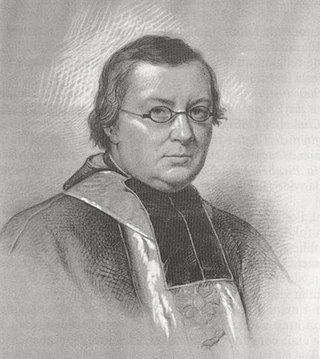
Jean-Jacques Bourassé was a French Roman Catholic priest, archaeologist and historian. He made his preparatory studies for the priesthood in Paris. In 1835, he taught the natural sciences at the preparatory seminary of Tours, where he began a course of archaeology that soon attracted attention. The results achieved by him in a comparatively new field of research were such as to entitle him to be considered a veritable pioneer in France of the science of Christian archaeology. In 1884 he became professor at the grand séminaire and held the chair of dogmatic theology there for six years. He then discontinued teaching in order to devote himself entirely to the preparation of his various archæological works. Among the productions published by him the best known are: Archéologie Chrétienne (1841); Les Cathédrales de France (1843); Les plus belles églises du monde (1857); Recherches historiques et archéologiques sur les églises romaines en Touraine (1869).
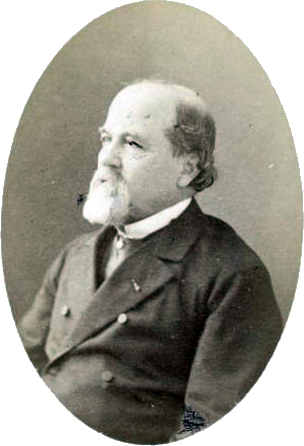
Alexandre Louis Joseph Bertrand was a French archaeologist born in Rennes.
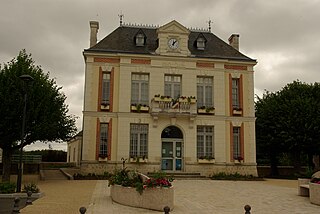
Chambourg-sur-Indre is a commune in the department of Indre-et-Loire in the region of Centre-Val de Loire, France.
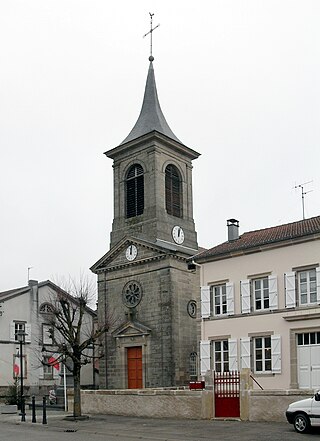
Mazeley is a commune in the Vosges department in Grand Est in northeastern France.
Augusta Viromanduorum is an ancient Gallo-Roman settlement, corresponding to the modern city of Saint-Quentin.

The Roman-Gaul Baths of Entrammes is a complex of Gallo-Roman thermal baths (thermae) in Entrammes, Mayenne, France. The baths were partially incorporated into a church with the hypocaust surviving below the new structure. The remains were discovered in 1987.
Roger Agache was a French archaeologist. He was among the first to take part in aerial archaeology in France, and helped to develop a methodology for aerial prospecting.

The Tours amphitheater is a Roman amphitheatre located in the historic city center of Tours, France, immediately behind the well known Tours cathedral. It was built in the 1st century when the city was called Caesarodunum. It was built atop a small hill on the outskirts of the ancient urban area, making it safe from floods, convenient for crowds and visitors, and demonstrating the power of the city from a distance. The structure was an enormous, elliptical structure approximately 122 meters by 94 meters. According to its design it is classified as a "primitive" amphitheatre. Unlike the famous Colosseum that was made mostly of masonry and built above-ground, the Tours amphitheatre was made mostly of earth and created by moving soil and rock into a bowl shape. Spectators likely sat directly on the grassy slopes, while the masonry was primarily used for the vomitoria and retaining walls.
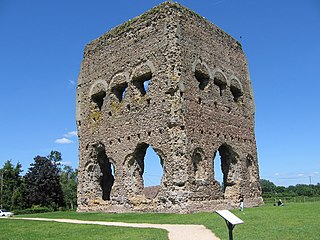
The "Temple of Janus" is a Romano-Celtic religious structure located in Autun, Saône-et-Loire, France, to the North-West of the ancient city of Augustodunum.
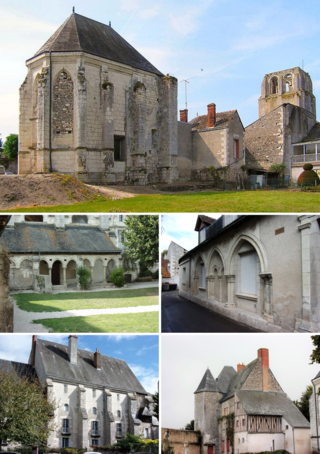
Comercy Abbey or Saint-Paul de Cormery Abbey is a former Benedictine abbey located on the territory of the commune of Cormery in the French department of Indre-et-Loire in the Centre-Val de Loire region.

The Jublains archeological site is a cluster of ruins, mostly dating back to Ancient Rome, in the current French commune of Jublains in the département of Mayenne in the Pays de la Loire.
Michel Laurencin was a French academic and historian who specialized in the history of Touraine.
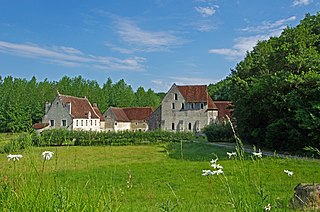
La Corroirie is a fortified feudal stronghold belonging to the neighboring Chartreuse du Liget, located in the commune of Chemillé-sur-Indrois, in the Indre-et-Loire department, Centre-Val de Loire region.

The Louroux Priory, also known as Château du Louroux, is located in the commune of Louroux in the French department of Indre-et-Loire, Centre-Val de Loire region. It was founded in the 12th century by the Marmoutier Abbey. At the time, the Benedictine monastery was one of nine priories belonging to the Touraine abbacy and located in the Tours diocese.
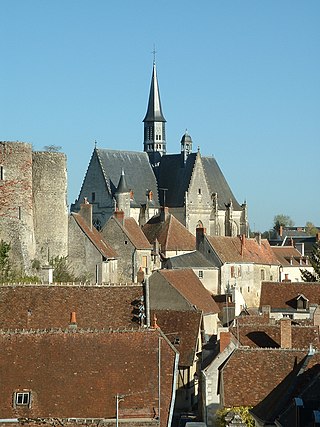
The Saint-Jean-Baptiste de Montrésor Church is a former collegiate church located in the city of Montrésor, part of the Indre-et-Loire department in France.